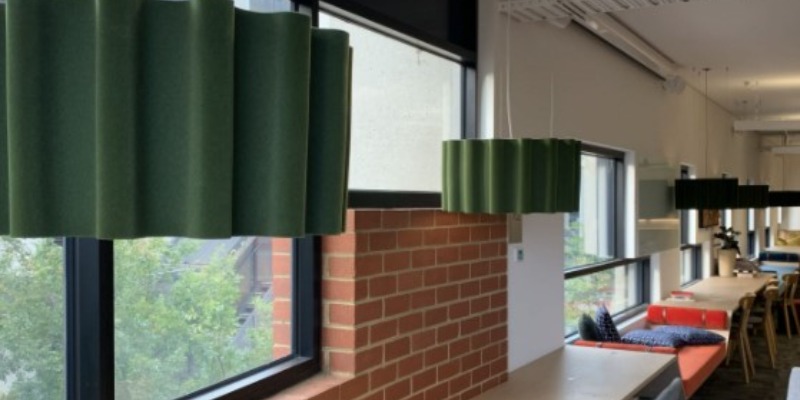Acustico lighting creates products that are aesthetically innovative as well as having acoustic properties to assist with sound management. Acustico Lighting's range is commercially viable as it can potentially increase productivity in collaborative spaces by helping to reduce noise.
Hear about Acustico Lighting and their journey to commercialisation and IP protection.
Acustico Lighting: Design and functionality
Samantha:
I have a background in interior design, and I was working in commercial interiors. Continually, I had clients that had a problem with noise. I decided that I really needed to create something that looked really good, but also solved that problem with sound. So it became evident to me that it would be a really good idea to suspend the solution. Because it's suspended, the sound waves bounce around a room, and then they are absorbed by the material that these lights are made of.
It's a bit of a triple threat. It has a light source, it absorbs sound, and it creates a great design punch in space. Inspirations for my design come from all over the place. Then I set about sketching and then taking those to the manufacturer.
My design journey for commercialisation started with an accelerator program I did. During that time, we heard from an IP lawyer, and I always knew that I needed to register the designs, but I did not know anything about how to go about that. It was really fortunate that that happened right at that time, because I was actually about to launch the product on a website. I recognised at that point that I needed to register the designs prior to actually showing it. So I chose to work with an IP lawyer to register the designs and to go through the trade marking process, purely because I have no experience in this category at all, myself. Probably for my next designs, I will attempt to do that myself, but because I'm a little bit more educated in the process now.
Our lights are made in Australia and they're made from responsible materials. They're custom-made, so we don't have a warehouse full of stock. They're made to order. So much happens behind the scenes, and to get a product to market is so expensive. For then it to be copied for a much cheaper price, say off-shore, number one, dilutes the value of your product in the marketplace. It also leaves you with nothing to sell at the end. I think it's really important that our laws protect designers who are creative enough to innovate.
I have a background in interior design, and I was working in commercial interiors. Continually, I had clients that had a problem with noise. I decided that I really needed to create something that looked really good, but also solved that problem with sound. So it became evident to me that it would be a really good idea to suspend the solution. Because it's suspended, the sound waves bounce around a room, and then they are absorbed by the material that these lights are made of.
It's a bit of a triple threat. It has a light source, it absorbs sound, and it creates a great design punch in space. Inspirations for my design come from all over the place. Then I set about sketching and then taking those to the manufacturer.
My design journey for commercialisation started with an accelerator program I did. During that time, we heard from an IP lawyer, and I always knew that I needed to register the designs, but I did not know anything about how to go about that. It was really fortunate that that happened right at that time, because I was actually about to launch the product on a website. I recognised at that point that I needed to register the designs prior to actually showing it. So I chose to work with an IP lawyer to register the designs and to go through the trade marking process, purely because I have no experience in this category at all, myself. Probably for my next designs, I will attempt to do that myself, but because I'm a little bit more educated in the process now.
Our lights are made in Australia and they're made from responsible materials. They're custom-made, so we don't have a warehouse full of stock. They're made to order. So much happens behind the scenes, and to get a product to market is so expensive. For then it to be copied for a much cheaper price, say off-shore, number one, dilutes the value of your product in the marketplace. It also leaves you with nothing to sell at the end. I think it's really important that our laws protect designers who are creative enough to innovate.
Please note: case studies are examples of the way some organisations have chosen to manage their IP. These studies don't provide advice and your experience may be different.

